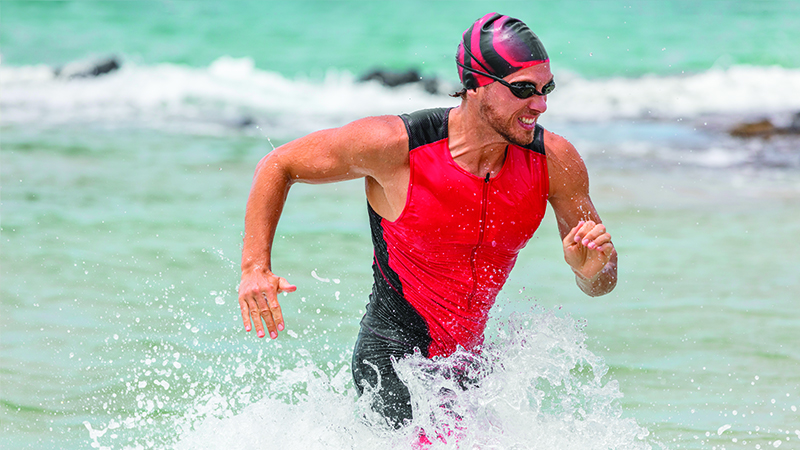Running a marathon no longer tops the stakes in fitness cred – it’s all about triathlons. So here’s our guide to training for your first event, plus a list of upcoming triathlon competitions in Asia.
While only a handful truly excel in this mentally and physically gruelling swim-bike-run sport, thousands around the world successfully attempt it in a bid to call themselves triathletes. Using our guide, some hard work, determination and buckets of sweat, you should be able to complete an Olympic distance triathlon before the year is out. Just a warning: we hear it’s addictive.
Leg 1 – Swimming: 1.5km
First-time athletes are often put off by open-water swimming – or, worse, they drop out entirely. You can take this leg at your own pace. Race organisers generally stagger the start times for athletes to prevent overcrowding in the water.
Once you have developed a good technique and stamina in the swimming pool, personal trainer Nicholas Lange suggests slotting in some open-water sessions in the ocean, in as calm a stretch of water as you can find. (Hong Kong is fortunate in that it has plenty of calm water.) Or, visit the actual race site to get familiar with the water conditions there.
Freestyle is the most efficient stroke as it creates less drag compared to breaststroke. First-timers should practice sighting during training to ensure they stay on course. Also, a good pair of swimming goggles will greatly increase visibility.
“Swimming in your first triathlon can be intimidating. It’s best to swim on the outside or behind the crowd or both, as being caught on the inside of a corner can be scary,” advises Nicholas.
Leg 2 – Cycling: 40km
A smooth transition from swim to bike (often referred to as Transition 1) is important, so schedule brick sessions during training to see what works for you and to get used to transitioning.
While road bike, mountain bike and hybrids are all allowed and used in this leg, triathlon coach Eduardo Finkelstein suggests spending your bucks on a road bike for a faster and more efficient ride. A road bike is versatile and can be used in training, racing and for leisure. Heavier bikes like mountain bikes may exhaust too much energy, leaving nothing for the upcoming run.
“Once you get started, it’s a good idea to buy clip-in pedals and clip-in shoes, as they will greatly improve your efficiency on the bike,” says Eduardo. It’s also a good habit to practise starting, stopping and clipping in and out of the pedals in an empty car park or quiet street during training.”
Always keep to the left side of the road to allow faster cyclists to overtake and check if drafting is allowed. The drafting zone is defined as a rectangular area of seven metres long by two metres wide. Needless to say, helmets are a safety regulation.
Keep a bottle filled with your favourite isotonic drink or water on the bike to hydrate every 20 minutes and refuel with a sports energy gel once every 45 to 60 minutes. It is especially important to do so early in the bike leg as it allows time for absorption before the run.
Leg 3 – Running: 10km
Transition 2 is fairly straightforward – push bike to transition area, rack bike, change from bike shoes to running shoes and off you go – though practice is still advised.
The last leg, which requires practically zero gear save for a trusty pair of running shoes, is the least technical but is more mentally and physically challenging after the swim and bike. At this point, athletes just have to dig deep to find energy for the final push on foot all the way to the finish line.
Many athletes who haven’t paced themselves throughout the race may experience bonking or hitting the wall. Leg cramps are fairly common too. This is especially true if you fail to replenish your energy with gels and isotonic drinks during the early bike and run legs. Shades and a well-ventilated cap help keep the sun off your head and may make the run more comfortable. “Look out for posture, arm swing and gait while running, as bio-mechanical inefficiencies can cause unwanted stress on the body,” says Nicholas.
Triathlete Talk
Sighting: Lifting your eyes out of the water to look ahead and around you.
Brick sessions: Training sessions where you do two disciplines back to back – for example, a swim followed immediately by a bike or a bike followed by a run.
Drafting: Act of riding behind another cyclist in an area of reduced air pressure, thus giving you an easier ride.
Transition: An area to store your equipment like bike, towel, running shoes and the process of changing disciplines during the race.
Race Day: Tips from the Pros
“Eat solid food like oatmeal or bananas three to four hours before the competition to allow the food to digest and replenish glycogen levels,” says Ironman certified coach and personal trainer Ram Toh. Ram completed multiple Ironman triathlons.
“Everything you do on race day should be a ritual that you are familiar with and know that works,” adds Eduardo Finkelstein. “It’s not the day to try something new. You can then focus on prepping yourself mentally and physically without having to bother about trivial matters.” Eduardo has previously raced as a professional triathlete in the ITU World Triathlon Series and has completed a host of Ironman triathlons, including three times in Kona.
Sprint, Olympic and Ironman – what’s the difference?
Sprint is a short-distance triathlon consisting of a 750m swim, 20km bike and 5km run.
Average completion time: One and a half hours.
Best for: Anyone, especially newbies.
Olympic Distance (OD) is the standard-length triathlon, introduced into the Sydney Olympics in 2000. 1.5km swim, 40km bike, 10km run.
Average completion time: Slightly under three hours, cut-off time is generally four hours. Olympians complete it in less than two hours.
Best for: Those looking for a tougher challenge.
Ironman 140.6, as the name suggests, consists of a highly gruelling 3.8km swim, 180km bike and 42.195km run. Ironman 70.3, also known as a Half Ironman, consists of a 1.9km swim, 90km bike and 21.1km run.
Average completion time: Usually 12 hours, with a 17-hour time limit. The current world record is seven hours, 40 minutes and 23 seconds set by British triathlete Tim Don in 2017.
Best for: Experienced triathletes who have competed at least two OD triathlons. Depending on how competitive you want to be, it may require a year of training to advance from OD to Ironman.
CALENDAR OF UPCOMING TRIATHLONS, 2019-2020
25 August: Ironman 70.3 Bintan, Indonesia
29 September: Singapore International Triathlon
24 November: Laguna Phuket Triathlon, Thailand
12 October: Hong Kong Sprint Triathlon Asian Cup
12 October: Tri Dash Phuket, Thailand
26 October: IM 70.3 Langkawi, Malaysia
27 October: Pattana Triathlon, Thailand
10 November, Bali International Triathlon, Indonesia
10 May 2020: Ironman Vietnam
Like this? See our Health & Fitness section for more!






